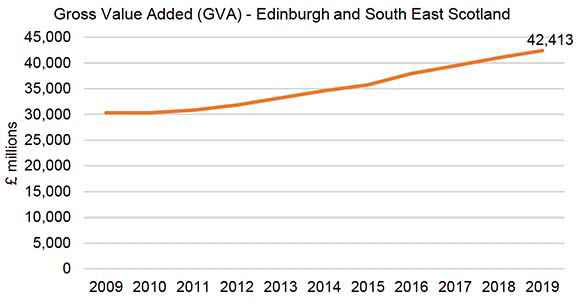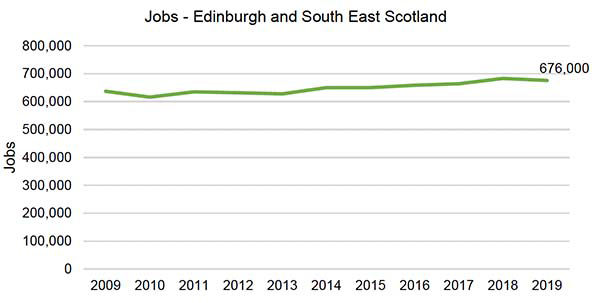Scotland National Strategy for Economic Transformation: Regional Economic Partnerships - evidence
This Paper provides summary evidence received from Scotland's Regional Economic Partnerships as part of the National Strategy for Economic Transformation engagement process.
3. Edinburgh and South East Scotland Regional Economic Partnership


Regional Aspirations to 2030
The vision for the region is stated in the Regional Prosperity Framework (2021-41) is as follows:
"…To become the data capital of Europe. We will ensure the social and economic benefits of this capability extend to all. All sections of the community will have the opportunity to develop the key skills that will help to end inequalities in our scoiety. We will protect our environment and make best use of our extraordinary built and natural assets, ensuring that the Edinburgh and South East Scotland City Region delivers a just tranisition to a net zero economy. Our institutions, ancient and modern, will deliver positive outcomes that enhance our local, national and international reputation."
The future regional economy will be shaped by nine major regional 'Big Moves' opportunities to drive the delivery of the Regional Prosperity Framework (2021 – 2041). Each of the Big Moves will support inclusive growth and net zero aspirations. The nine Big Moves are:
- Becoming the Data Capital of Europe;
- Re-thinking Our Place;
- Sustainable Transport;
- Regenerating the Forth;
- Sustainable Tourism and Culture;
- Supporting Enterprise;
- Aligning Skills;
- Re-Inventing Healthcare; and,
- Anchor Institutions.
Implementation plans are currently being developed for each of the Big Moves. The overall Implementation Plan will be taken to the City Region Deal Joint Committee for approval in September 2022.
Regional Opportunities
- The inclusion of Data-Driven Innovation in the City Region Deal reflected the critical importance of data in economic growth, social change, and public services. Five data-driven innovation 'hubs' are being created - along with a further centre of excellence in data science - housing expertise and facilities to work across multiple industrial sectors and to enable innovation through data.
- The region is projected to have strong economic growth. The average annual growth projections from 2020-2030 suggest a growth rate of 2.4%, which could be higher than the average annual growth projected for Scotland as a whole.
- Through the work of the Integrated Regional Employability & Skills (IRES) Programme, partners are jointly developing regional career pathways from the classroom to the workplace with employers to meet current and future skills requirements in key sectors across the region.
- Supply of affordable housing is a particular challenge in this region. This also presents a significant economic opportunity with the right support, investment, innovation and resource, alongside an infrastructure-first approach, to enable the region to deliver at pace and scale. The seven strategic sites identified in the City Region Deal and the Edinburgh Home Demonstrator project present scope to develop a pipeline of low carbon homes that can be delivered through offsite manufacturing. This complements more local approaches to identify and develop key housing and employment sites through Strategic Development Areas (SDAs).
- There is an opportunity to take advantage of changes in ways of working following the pandemic to improve connectivity, particularly for more rural areas, hybrid working and the through increased investment in public and active travel, in line with net zero carbon ambitions.
- Other opportunities include regeneration of the Forth to create a national focus for renewables investment, and the mixed use regeneration potential along the Firth and coast to confirm the region's place as a leading European Waterfront destination.
Regional Challenges
- Most of the region's GVA is concentrated at the core of the city region. For example, GVA in the Scottish Borders in 2021 is forecasted to be £2,065 million, compared to a forecast for the City Region area of £40,171 million. Productivity in the Scottish Borders is well below the City Region average at just over £40,000 per head compared to £56,000 per head. The Regional Prosperity Framework recognises these disparities and seeks to ensure the social and economic benefits felt in some parts of the city region extend to all.
- Digital connectivity varies significantly across the region with some rural parts still receiving patchy coverage, leading to lower levels of resilience due to poor connectivity and lower rates of home working.
- As a growing region, there is a need to ensure that new housing and areas of business development are accessible by public and active transport, and that car dependency is reduced, in line with net zero carbon ambitions.
- As we come out of the pandemic, the region's once thriving tourism, hospitality and culture sectors will need to be supported to recover to pre-pandemic levels and to attract people back to work in those sectors; many who lost jobs during the pandemic will have secured employment elsewhere.
Ongoing and Planned Activity for Region
- The Regional Prosperity Framework (2021-2041) seeks to deliver on the following priorities: High Quality Places and Investment in Homes and Neighbourhoods; Major housebuilding programme across all types and tenures; 20-minute neighbourhoods; taking a new approach which builds on the opportunities for flexible and digitally supported working; Educational institutions, particularly the research-intensive Universities; Support for key growth areas of the economy; A commitment to more locally based supply chains; Acceleration of growth through infrastructure upgrades and reduction of carbon emissions.
- The £1.3 billion Edinburgh and South East Scotland City Region Deal agreed in 2018 by regional partners and the UK and Scottish Governments aims to deliver on the following themes: Research, Development and Innovation (which supports Healthcare, Artificial Intelligence, Agritech, Financial Services and Food and Drink.
- Integrated Regional Employability and Skills programme (which includes data and construction skills gateways)
- Transport
- Culture
- Housing
- The City Region Deal is holistic and cut across policy areas including planning, housing, economic development, transport, net zero, innovation and skills. It aims to address the region's challenges and opportunities to make Edinburgh and South East Scotland a better place to live, work, study, visit and invest for current and future generations. At the time of writing, work is underway on developing an Implementation for the Regional Prosperity Framework for the next 20 years. This will be taken to Joint Committee for approval in September 2022.
Contact
Email: Cornilius.Chikwama@gov.scot
There is a problem
Thanks for your feedback